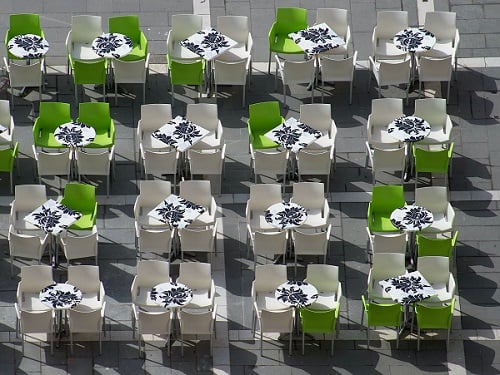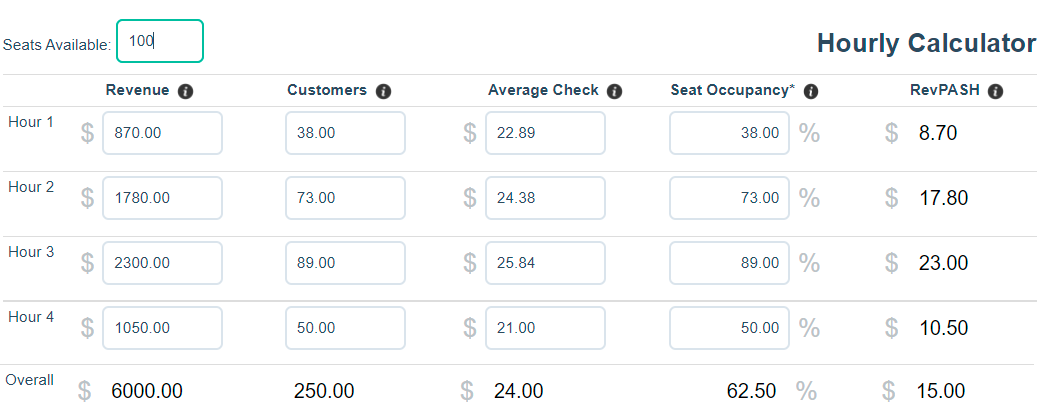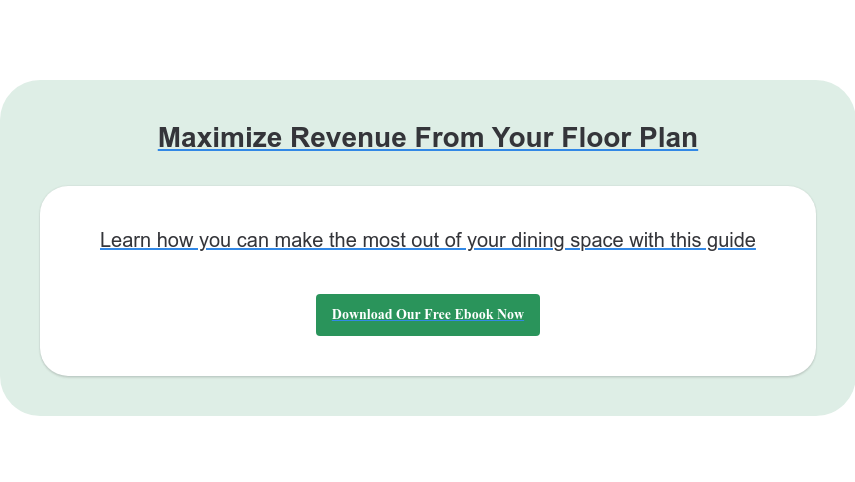
Are you using your dining space to its full potential?
One way to answer this question is to look at revenue metrics, like average check size or total sales. The problem though is that they don't take seat occupancy into account.
Let’s say you only had a handful of diners for lunch, but they all ordered a lot of food and drinks. Check size will be above average, but you probably won’t have made enough to break even. Or, if you’re happy with the number of sales during the shift, how do you know whether you could have made more by turning tables faster?
Occupancy metrics have a similar problem: they leave revenue out. If a dining room is full but, diners engage in table talk without spending enough, you won’t be making what you could've when it comes to revenue.
You need a better metric to measure the performance of your dining room in your restaurant operations. It’s called RevPASH, which stands for Revenue Per Available Seat per Hour, and takes into account revenue, seats, and time altogether.
Let's investigate what RevPASH means for your restaurant business.
What exactly is RevPASH?
If your hotel has a restaurant or other food and beverage outlets, you must comply with the RevPASH rule, which stands for revenue per available seat hour. RevPASH also happens beyond the hospitality sector, for example, at hair salons where appointments on the weekends are more expensive due to a lack of availability.
Launched in 1998, RevPASH can be computed hourly, weekly, or monthly.
Understanding the utilization and income of a "seat" and planning your food and beverage operations more effectively are both made possible by tracking the RevPASH.
>>> Want to know more about improving your hotel guest experience? Download our free guide today.
When should restaurant revenue management calculate RevPASH?
Calculating RevPASH is usually a good idea if you're a food and beverage manager. Especially when the restaurant is busy and has a regular stream of patrons, that's when it becomes essential. This might be used to define a restaurant that has moved past the beginning and is prepared to make the most of each patron.
How to calculate RevPASH
One way to calculate RevPASH is to pick a period of reference (shift, day, week, etc.) and divide the revenue for that period by the number of seating hours. Seating hours are the number of available seats multiplied by the number of hours in the chosen period.
For example, if you made $6,000 during a 4-hour dinner shift and you have 100 seats, your RevPASH would be:
6,000 / (4x100) = $15
$15 is the average revenue that each available seat – whether occupied or free – generated during every hour of the shift.
The great thing about RevPASH is that it puts time at the center of the equation.
According to Sheryl E. Kimes, Emeritus Professor of Operations Management at the Cornell University School of Hotel Administration, who invented this metric, selling time is ultimately each restaurant’s core business: “On the surface, restaurants sell meals, [...], in reality, restaurant operators sell time in the form of meals of reasonably predictable length.” Time, not food, is the ultimate perishable inventory, says Kimes: food can be frozen and kept intact indefinitely, but once the time is gone it’s gone.
Why should your hotel implement the RevPASH formula?
If you run a hotel restaurant or you're in the hospitality industry, RevPASH is a wonderful metric to monitor every day. You may use it to track the results of any changes you make to your revenue management strategy and pinpoint any problems you need to solve.
For instance, you might change your layout to accommodate more tiny tables if you see that are arriving at your restaurant in small groups of two or three. This would enable an average of more diners to be seated.%20(1).png?width=1400&height=788&name=Untitled%20design%20(39)%20(1).png)
Collecting more RevPASH data
Calculating RevPASH is only the first step. To know how to improve it, we need to consider a new restaurant data point: the number of customers served. In the case of our example, let’s suppose it’s 250. From here, we can reintroduce the two metrics we mentioned above: average seat occupancy and check size.
Seat occupancy indicates the average percentage of seats that were occupied during the shift. The formula is:
(Customers/seating hours) x 100
(250/400) x 100 = 62,5%
While the formula for average check size is:
Revenue/number of guests
$6,000 / 250 = $24
The next thing to do is break down revenue and the number of guests by each hour of the shift. (You can easily get this data from the POS system.) The reason why we’re doing this is that all the metrics we have calculated so far are averages, but within the same shift, there can be significant variations.
An easy way to do the math is to use this RevPASH calculator developed by Boston University. This is what it would look like with our example:
As we can see, all metrics (seat occupancy, check size, and RevPASH) are above average during second and third peak hours, and below average during hours 1 and 4.
How to improve RevPASH in a restaurant
Knowing what needs to be improved will help you choose the best approach to increase RevPASH.
Generally, there are two ways to do that.
1. Optimize seating
There could be two reasons why that's not happening. One is that they remain empty for too long. In other words, seat occupancy is too low, as it happens during the first and last hour in our example. In that case, you could:
- Attract more diners during non-peak hours. It could be a flat discount on the bill or the classic early bird menu
- Distribute reservations more evenly throughout the shift
- Revise your table mix. For example, each time a party of two is seated at a table for four, the two extra seats will be irremediably wasted. If your table and guest mix don’t quite match, you can use this Table Mix Optimizer to reassess it
- Reduce no-shows and late cancellations by sending reminders for upcoming reservations or charging a non-refundable deposit at the moment of booking
- Practice strategic overbooking. Hotels and airlines are doing it, so why not restaurants?
Did you know you can do most of the things above using the Eat App widget and table management system? Check all features here, or watch this full demo.
The other reason why seats are not making enough money is that they remain occupied for too long. A table is taken from the moment it’s assigned to new guests until it’s ready for the next ones. This length of time can be broken down into several steps. Each one can be timed and optimized:
- Assigning the table
- Ordering
- Serving food
- Paying
- Bussing and changeover
Even if you get to shave off one minute for each, it will add up to a lot of time eventually.
A step that is notably missing from the list above is the time guests take to eat the meal. Unless you have a clear timing policy (for example, two slots of two hours), or you ask lingering guests to leave, you won’t have complete control over that part. However, strategic pre-bussing can be an effective persuasive technique.
>>> Want to increase your table turnaround time? Request a demo today!
2. Increase Guest Spend
The other reason why RevPASH could be higher is that seats are not making enough money while they are occupied by guests.
One solution is upselling. That, however, may not always be the best choice. With a full dining room and more guests on the waiting list, it’s probably better to make tables available quickly for the next party, rather than proposing another round of drinks. By contrast, if the dining room is half empty and you’re not sure whether more guests will arrive, upselling to those you already have is an excellent idea.
The other way to make guests spend more is to charge more for the food. If your customers are not price sensitive, you could simply raise menu prices.
A subtler technique is to apply demand-based pricing. In this case, the price will be determined by demand (and therefore by the perceived value of the meal) rather than the classic profit + cost formula. Airlines and hotels do this routinely, by charging more during weekends simply because demand is higher.
But while travelers are willing to tolerate this approach, diners are much less forgiving. They don’t consider the time of the meal as part of its value (although it certainly is). One solution is to create special menus with a higher price for peak hours. This might discourage some customers, but the trade-off with a higher check price may result in a higher RevPASH.
FAQs
By taking the hourly revenue and dividing it by the number of seats you have, you can calculate RevPASH. Your RevPASH will be lower than it might be if only half the restaurant is occupied, and it will be lower still if everyone orders only one course.
When RevPASH is relatively low, upselling may be the ideal method for boosting sales. Conversely, when RevPASH is higher, it's probably in your best interest to turn the tables, given that customers are waiting.












.webp?width=144&height=72&name=Eat%20App%20Logo%20(3).webp)